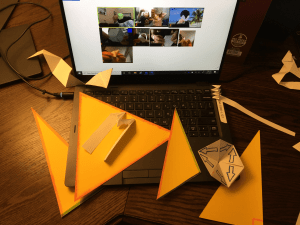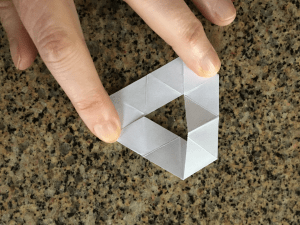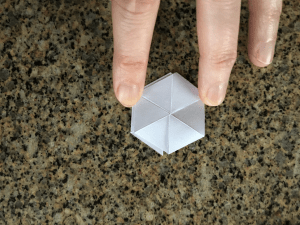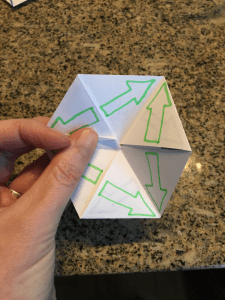 Prefer a printout? Here you go: Exploring Hexaflexagons
Prefer a printout? Here you go: Exploring Hexaflexagons
When making a hexaflexagon, take your time and enjoy the journey. There are all kinds of surprises waiting for you in every fold of this paper gizmo! For this exploration you will need:
- a sheet of note paper (8.5 x 11) cut lengthwise into approximately 2 cm wide strips.
- a ruler and a protractor
- a glue stick or tape
- a pencil and something with which to colour
Exploration 1: The V-Shape
We are going to do some experimenting!
- Fold your strip of paper so that it makes a V-shape.
- Next, hold your V up to a light source. A window or a lamp works well. Look carefully at the base of the V. What sort of shape do you notice? Use a pencil to carefully trace around the shape.
- Measure the sides and the angles. What do you notice? Record your ideas.
There are four possible triangles you might have created: an isosceles triangle, an equilateral triangle, a right angle triangle and a scalene triangle.
- Which one did you create? How do you know?
- Play around with your strips of paper. Can you make all four kinds of triangles? Write down what you accomplished and what your thoughts are. Is it even possible to make all four?
Use your protractor to measure the angle that sits inside the bottom of your V-shape.
- Can you predict what sort of triangle you made just by measuring this angle? Make sure you test this idea several times and record what you notice.
Exploration 2: Folding Congruent Triangles
In order to make a hexaflexagon, you need to fold a line of congruent triangles. However, what kind of triangles are the best for this?

- Try working with an isosceles, right-angle, equilateral, and scalene triangle. Fold your paper strip so that you end up with a line of triangles that are all the same shape and size (congruent). By the way, use a back-and-forth fold instead of a rolling fold.
- Is it possible to fold all of them? Which ones seem to work best and why? Record what you notice.
- When you unfold your stacks of folded triangles, what do you notice? Do some unfold in a particular way? What do you notice about the triangles that are next to one another?
Exploration 3: Creating Shapes From Lines of Triangles
You will likely have noticed that two triangles result in a pretty satisfying line of congruent triangles: the right-angle triangle and the equilateral triangle. Now we are going to play with these lines of triangles to see what kind of shapes we can make!
- What kinds of shapes result from folding lines of right-angle triangles? What do they have in common?
- What kinds of shapes result from folding lines of equilateral triangles? What do they have in common?
Teachers and parents: encourage students to test for different polygons and lines! Here are a few examples:





Exploration 4: Making The Hexagon
By now, you have probably figured out that you cannot make a hexagon shape from a line of congruent right-angle triangles. The equilateral triangle is the key!
So: time make our hexaflexagon. To make a starter flexagon, you will need a line of 9 equilateral triangles in a row.
- Play around and see if you can make a hexagon. You will notice 1 extra triangle left over. Fold this one over and glue or tape it down. You should have a nice stable hexagon with no major gaps.
- Now you are going to make sure your hexagon is nice and flexible along all fold lines. Fold it along every line forward and back to make sure it is good and flexible.
- You should be ready to pinch your hexagon so that you make a three pointed star-shape. Gently open the top of the star. You will see…another hexagon! Pinch it to make another star shape and repeat:




Exploration 5: Playing with Designs
Grab some pencils or markers and start to colour your hexagon. Colour both sides a different colour. Add some extra designs if you like.
- Pinch and open your hexagon now. What do you notice?
- When you have coloured all possible surfaces of your hexagon, you can even unfold it to see what happens. Before you do it, make a prediction: what do you think it will look like?
- Make more hexaflexagons! Create different kinds of designs! Play and experiment. What do you notice?
Finally:
- Time to do some thinking! What do you think is going on here? Why does the hexaflexagon work the way it does?
- Challenge yourself! Can you make a double hexaflexagon that shows six possible designs instead of three? What about a triple? Is it even possible? What happens when you try?
- Can other shapes flex? Sure! Try out a quadriflexagon. Can you figure out how to make one?
If you just want the basic directions:
- Click here for a standard hexaflexagon.
- Click here for a double hexaflexagon.
- Click here for the quadriflexagon.
If you find the folding problematic, try a template:
Have fun everyone and good luck!
